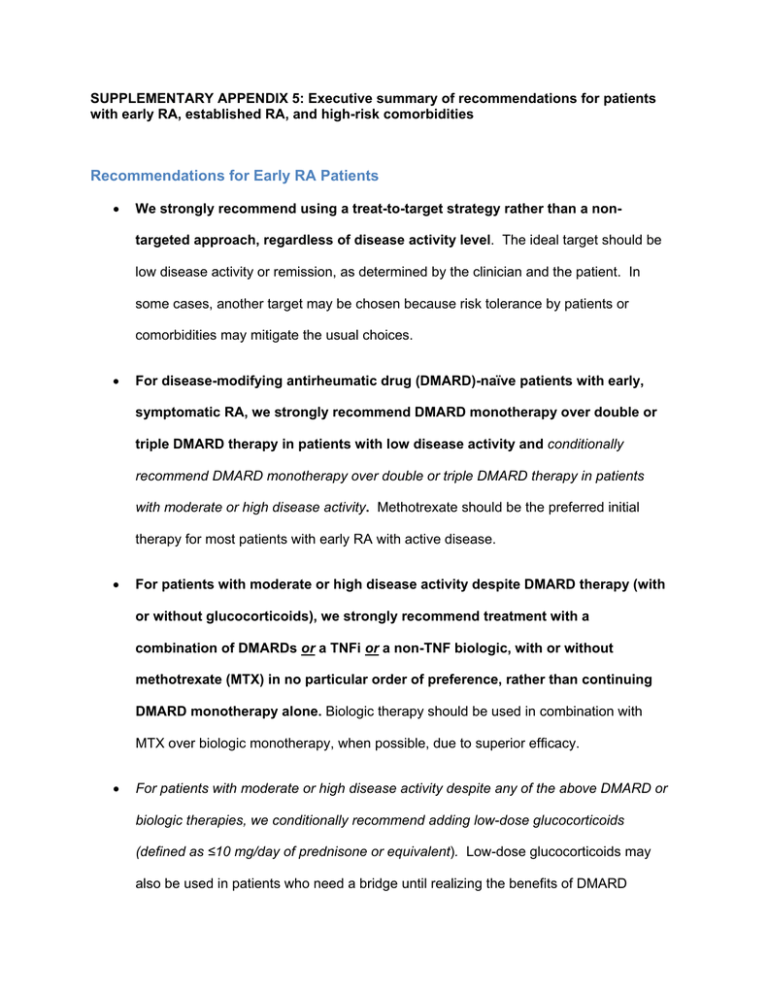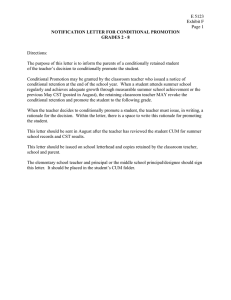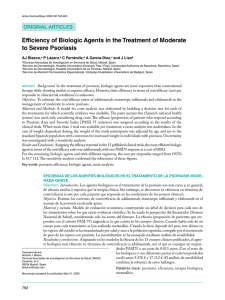Recommendations for Early RA Patients
Anuncio

SUPPLEMENTARY APPENDIX 5: Executive summary of recommendations for patients with early RA, established RA, and high-risk comorbidities Recommendations for Early RA Patients We strongly recommend using a treat-to-target strategy rather than a nontargeted approach, regardless of disease activity level. The ideal target should be low disease activity or remission, as determined by the clinician and the patient. In some cases, another target may be chosen because risk tolerance by patients or comorbidities may mitigate the usual choices. For disease-modifying antirheumatic drug (DMARD)-naïve patients with early, symptomatic RA, we strongly recommend DMARD monotherapy over double or triple DMARD therapy in patients with low disease activity and conditionally recommend DMARD monotherapy over double or triple DMARD therapy in patients with moderate or high disease activity. Methotrexate should be the preferred initial therapy for most patients with early RA with active disease. For patients with moderate or high disease activity despite DMARD therapy (with or without glucocorticoids), we strongly recommend treatment with a combination of DMARDs or a TNFi or a non-TNF biologic, with or without methotrexate (MTX) in no particular order of preference, rather than continuing DMARD monotherapy alone. Biologic therapy should be used in combination with MTX over biologic monotherapy, when possible, due to superior efficacy. For patients with moderate or high disease activity despite any of the above DMARD or biologic therapies, we conditionally recommend adding low-dose glucocorticoids (defined as ≤10 mg/day of prednisone or equivalent). Low-dose glucocorticoids may also be used in patients who need a bridge until realizing the benefits of DMARD therapy. The risk/benefit ratio of glucocorticoid therapy is favorable as long as the dose is low and the duration of therapy is short. For patients experiencing a flare of RA, we conditionally recommend adding short-term glucocorticoids (< 3 months of treatment) at the lowest possible dose for the shortest possible duration, to provide a favorable benefit-risk ratio for the patient. Recommendations for Established RA Patients We strongly recommend using a treat-to-target strategy rather than a nontargeted approach, regardless of disease activity level. The ideal target should be low disease activity or remission, as determined by the clinician and the patient. In some cases, however, another target may be chosen because tolerance by patients or comorbidities may mitigate the usual choices. For DMARD-naïve patients with low disease activity, we strongly recommend using DMARD monotherapy over a TNFi. For DMARD-naïve patients with moderate or high disease activity, we conditionally recommend DMARD monotherapy over double or triple DMARD therapy and DMARD monotherapy over tofacitinib. In general, MTX should be the preferred initial therapy for most patients with established RA with active disease. For patients with moderate or high disease activity despite DMARD monotherapy including methotrexate, we strongly recommend using combination DMARDs or adding a TNFi or a non-TNF biologic or tofacitinib (all choices with or without methotrexate) in no particular order of preference, rather than continuing DMARD monotherapy alone. Biologic therapy should be used in combination with MTX over biologic monotherapy, when possible, due to its superior efficacy. For all scenarios for established RA below, treatment may be with or without MTX. For moderate or high disease activity despite TNFi therapy in patients currently not on a DMARD, we strongly recommend that one or two DMARDs be added to TNFi therapy rather than continuing TNFi therapy alone. If disease activity is moderate or high despite single TNFi biologic therapy, we conditionally recommend using a non-TNF biologic. If disease activity is moderate or high despite non-TNF biologic therapy, we conditionally recommend using another non-TNF biologic. However, if a patient has failed multiple non-TNF biologics and they are TNFi-naïve with moderate or high disease activity, we conditionally recommend treatment with a TNFi. For patients with moderate or high disease activity despite prior treatment with at least one TNFi and at least one non-TNF-biologic (sequentially, not combined), we conditionally recommend first treating with another non-TNF biologic. However, when a non-TNF biologic is not an option (e.g., patient declines non-TNF biologic therapy due to inefficacy or side effects), we conditionally recommend treatment with tofacitinib. If disease activity is moderate or high despite the use of multiple (2+) TNFi therapies (in sequence, not concurrently), we conditionally recommend non-TNF biologic therapy and then conditionally treating with tofacitinib when a non-TNF biologic is not an option. If disease activity is moderate or high despite any of the above DMARD or biologic therapies, we conditionally recommend adding low-dose glucocorticoids. If patients with established RA experience an RA flare while on DMARD, TNFi, or nonTNF biologic therapy, we conditionally recommend adding short-term glucocorticoids (< 3 months of treatment) at the lowest possible dose and for shortest possible duration to provide the best benefit-risk ratio for the patient. In patients with established RA and low disease activity but not remission, we strongly recommend continuing DMARD therapy, TNFi, non-TNF biologic or tofacitinib rather than discontinuing respective medication. In patients with established RA currently in remission, we conditionally recommend tapering DMARD therapy, TNFi, non-TNF biologic, or tofacitinib. We strongly recommend not discontinuing all therapies in patients with established RA in disease remission. Recommendations for RA patients with High-risk comorbidities Congestive Heart Failure In patients with established RA with moderate or high disease activity and New York Heart Association (NYHA) class III or IV congestive heart failure (CHF), we conditionally recommend using combination DMARD therapy, a non-TNF biologic, or tofacitinib rather than a TNFi. If patients in this population are treated with a TNFi and their CHF worsens while on the TNFi, we conditionally recommend switching to combination DMARD therapy, a non-TNF biologic, or tofacitinib rather than a different TNFi. Hepatitis B In patients with established RA with moderate or high disease activity and evidence of active hepatitis B infection (hepatitis surface antigen positive > 6 months), who are receiving or have received effective antiviral treatment, we strongly recommend treating them the same as patients without this condition. For a patient with natural immunity from prior exposure to hepatitis B (i.e., HB core antibody and HBS antibody positive and normal liver function tests), we recommend the same therapies as those without such findings as long as the patient’s viral load is monitored. For patients with chronic hepatitis B who are untreated, referral for antiviral therapy is appropriate prior to immunosuppressive therapy. Hepatitis C In patients with established RA with moderate or high disease activity and evidence of chronic hepatitis C virus (HCV) infection, who are receiving or have received effective antiviral treatment, we conditionally recommend treating them the same as the patients without this condition. We recommend that rheumatologists work with gastroenterologists and/or hepatologists who would monitor patients and reassess the appropriateness of antiviral therapy. This is important considering the recent availability of highly effective therapy for HCV, which may lead to a greater number of HCV patients being treated successfully. If the same patient is not requiring or receiving antiviral treatment for their hepatitis C, we conditionally recommend using DMARD therapy rather than TNFi. Malignancy Previous Melanoma and Non-Melanoma Skin Cancer In patients with established RA and moderate or high disease activity and a history of previously treated or untreated skin cancer (melanoma or non-melanoma), we conditionally recommend the use of DMARD therapy over biologics or tofacitinib. Previous Lymphoproliferative Disorders In patients with established RA with moderate or high disease activity and a history of a previously treated lymphoproliferative disorder, we strongly recommend using rituximab rather than a TNFi and conditionally recommend using combination DMARD therapy, abatacept or tocilizumab rather than TNFi. Previous Solid Organ Cancer In patients with established RA with moderate or high disease activity and previously treated solid organ cancer, we conditionally recommend that they be treated for RA just as one would treat an RA patient without a history of solid organ cancer. Serious Infections In patients with established RA with moderate or high disease activity and previous serious infection(s), we conditionally recommend using combination DMARD therapy or abatacept rather than TNFi. Recommendations for the Use of Vaccines in RA patients on DMARD and/or biologic therapy In early or established RA patients aged 50 and over, we conditionally recommend giving the herpes zoster vaccine before the patient receives biologic therapy or tofacitinib for their RA. In early or established RA patients who are currently receiving biologics, we conditionally recommend that live attenuated vaccines such as the herpes zoster (shingles) vaccine not be given. In patients with early or established RA who are currently receiving biologics, we strongly recommend using appropriately indicated killed/inactivated vaccines.




